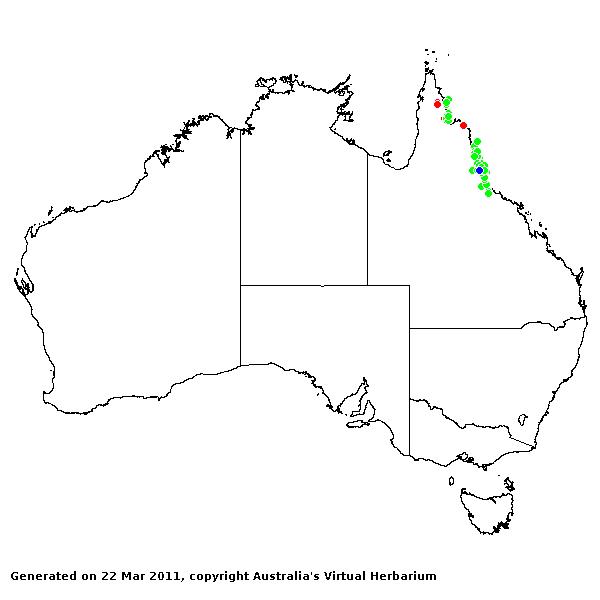Cyrtococcum Fl. Trop. Afr. 9: 15 (1917).
Derivation:. From kyrtos (curved) and kokkus (grain or fruit), alluding to the shape of the fruit.
Taxonomic revisions, nomenclatural references:. B.K.Simon, Austrobaileya 3: 585 (1992).
Key references (keys and floras):. E.E.Henty, Manual Grasses New Guinea 57, 60 (1969); M.Lazarides, Tropical Grasses S.E. Asia 111–112 (1980); R.D.Webster, Australian Paniceae 34–35 (1987); B.K.Simon, Key to Australian Grasses 89–90 (1993); D.Sharp and B.K.Simon, AusGrass (2002).
W.D.Clayton & S.A.Renvoize, Genera Graminum (1986), genus (472).
Native. 12 species, from Old World tropics. 2 species in Australia, Qld. Also New Guinea and Malesia.
Habit. Perennial, stoloniferous or decumbent. Leaf blades broad or narrow, cordate or not cordate. Ligule an unfringed membrane to a fringed membrane.
Inflorescence. Inflorescence paniculate, an open panicle with branches ending in single spikelets, open or contracted.
Spikelets. Spikelets 2 flowered, with 1 fertile floret, solitary, pedicelled. Fertile spikelets with lower incomplete floret(s), oblong or elliptic or obovate, gibbous, laterally compressed, falling with glumes.
Glumes. Glumes more or less equal, shorter than spikelet, shorter than adjacent lemmas, awnless, keeled, similar (membranous, the upper blunt). Lower glume 1–3 nerved. Upper glume 3 nerved.
Florets. Lower incomplete floret(s) sterile. Lemmas blunt, awnless, 3–5 nerved, more or less equalling fertile lemmas, less firm than fertile lemmas to decidedly firmer than fertile lemmas, not becoming indurated. Fertile florets 1. Lemmas naviculate, gibbous on the back, saccate, decidedly firmer than glumes (papery to crustaceous), smooth or striate, becoming indurated to not becoming indurated, white in fruit, entire at apex, pointed, crested at tip, muticous, with a clear germination flap, 5 nerved, glabrous (smooth, shiny), having margins tucked into palea, 1 keeled. Palea relatively long, entire, textured like lemma, indurated or not indurated, 2 nerved. Lodicules 2. Stamens 3. Grain small, compressed laterally. Hilum short. Embryo large.
Kranz Anatomy. C3.
Commonly adventive.
Habitat. Mesophytic. Forests. Shade species.
Classification. Panicoideae; Isachneae.
Notes. Diagnostic features include the lateral compression of the spikelets, a crested apex on the upper lemma and the gibbose upper glume and upper lemma (Webster, 1987).
Types Species. C. setigerum Stapf = C. chaetophoron (Roem. & Schult.) Dandy.
Biogeographic Element. Clifford & Simon 1981, Simon & Jacobs 1990: Old World Tropics.


